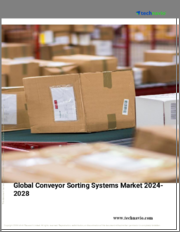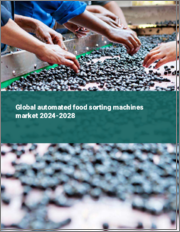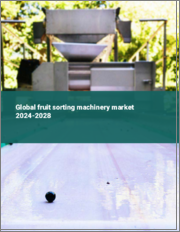
|
시장보고서
상품코드
1566322
자동 분류 시스템 시장 : 유형별, 처리 능력별, 용도별, 최종사용자 산업별, 지역별, 기회, 예측(2017-2031년)Automated Sorting Systems Market Assessment, By Type, By Throughput, By Application, By End-user Industry, By Region, Opportunities and Forecast, 2017-2031F |
||||||
세계의 자동 분류 시스템 시장 규모는 예측 기간인 2024-2031년에 6.40%의 CAGR로 확대하며, 2023년 70억 6,000만 달러에서 2031년에는 116억 달러로 성장할 것으로 예측됩니다.
분류 시스템은 다양한 상품과 패키지의 유통에 관련된 분야에서 중요한 장비입니다. 자동화 시스템은 AI 기반 광학 선별, 비적외선(NIR) 기술, 로봇 공학, 자동 선별 등 다양한 혁신을 통해 업그레이드되어 왔으며, AI와 로봇 선별 기술은 재활용 산업에 혁명을 일으켜 효율성, 재료의 순도 및 지속가능성을 향상시키고 있습니다. 그 잠재력을 극대화하기 위해서는 협업과 혁신이 필수적입니다.
최첨단 선별 기술의 통합으로 재활용의 상황이 변화하고 있습니다. 또한 로봇 공학이 재활용 업무에 통합되면서 자재 취급 및 선별이 변화하고 있습니다. 벨트 컨베이어 위의 원료는 AI 알고리즘과 정밀한 파지 기술을 갖춘 첨단 로봇 시스템을 통해 효율적으로 이동 및 선별됩니다. 이 로봇 팔은 미리 설정된 기준에 따라 특정 품목을 인식하고 선택하도록 설계되어 정확하고 빠른 분류에 도움이 됩니다. 로봇 공학은 분류 절차의 적응성과 유연성을 향상시켜 실수를 줄이고 생산성을 높입니다. 기업은 생산성을 높이고 새로운 기술을 가속화하기 위해 자동 배송 및 분류 기계를 도입하는 경향이 있습니다.
예를 들어 2024년 3월 DHL Express India는 뉴델리에 첫 번째 자동 배송 분류 허브를 도입했습니다. 34,256평방피트 규모에 시간당 2,000개를 분류할 수 있는 이 새로운 자동 분류 허브는 18개의 분류 슈트, 11개의 트럭 도크, 8개의 텔레스코픽 컨베이어, 18개의 분류 슈트, 11개의 트럭 도크, 8개의 텔레스코픽 컨베이어, 인바운드 화물의 신속한 처리에 기여하여 고객의 운송 시간이 단축되었습니다.
세계의 자동 분류 시스템 시장에 대해 조사했으며, 시장의 개요와 유형별, 처리 능력별, 용도별, 최종사용자 산업별, 지역별 동향 및 시장에 참여하는 기업의 개요 등을 제공하고 있습니다.
목차
제1장 프로젝트의 범위와 정의
제2장 조사 방법
제3장 개요
제4장 고객의 소리
제5장 세계의 자동 분류 시스템 시장 전망, 2017-2031년
- 시장 규모 분석과 예측
- 시장 점유율 분석과 예측
- 시장 맵 분석, 2023년
- 유형별
- 처리 능력별
- 용도별
- 최종사용자 산업별
- 지역별
제6장 북미의 자동 분류 시스템 시장 전망, 2017-2031년
제7장 유럽의 자동 분류 시스템 시장 전망, 2017-2031년
제8장 아시아태평양의 자동 분류 시스템 시장 전망, 2017-2031년
제9장 남미의 자동 분류 시스템 시장 전망, 2017-2031년
제10장 중동 및 아프리카의 자동 분류 시스템 시장 전망, 2017-2031년
제11장 수요공급 분석
제12장 수출입 분석
제13장 밸류체인 분석
제14장 Porter's Five Forces 분석
제15장 PESTLE 분석
제16장 가격 분석
제17장 시장 역학
제18장 시장의 동향과 발전
제19장 사례 연구
제20장 경쟁 구도
- 시장 리더 TOP 5의 경쟁 매트릭스
- 참여 기업 TOP 5의 SWOT 분석
- 시장의 주요 참여 기업 TOP 10의 상황
- Honeywell International Inc.
- Bastian Solutions Inc.
- Beumer Group GmbH
- Daifuku Co. Ltd.
- Siemens AG
- TGW Logistics Group
- Redwave(BT-Wolfgang Binder GmbH)
- OPEX Corporation
- Dematic(KION Group)
- Leonardo S.P.A.
제21장 전략적 제안
제22장 문의와 면책사항
KSA 24.10.15Global automated sorting systems market is projected to witness a CAGR of 6.40% during the forecast period 2024-2031, growing from USD 7.06 billion in 2023 to USD 11.60 billion in 2031.
Sortation systems have been crucial equipment in sectors that involve the dissemination of diverse goods and packages. Automated systems have been upgraded through diverse innovations, including AI-powered optical sorting, Non-infrared (NIR) technology, robotics, and automated sorting. AI and robotic sorting technologies are revolutionizing the recycling industry, enhancing efficiency, material purity, and sustainability. Collaboration and innovation are crucial for maximizing their potential.
The recycling landscape is transforming with the integration of cutting-edge advanced sorting technologies. Furthermore, material handling and sorting have changed as a result of robotics' inclusion in recycling operations. Materials on conveyor belts can be efficiently moved and sorted by sophisticated robotic systems equipped with AI algorithms and precision gripping technology. These robotic arms help with precise and quick sorting since they are designed to recognize and choose particular items based on predetermined criteria. Robotics improve sorting procedures' adaptability and flexibility, reducing mistakes and increasing productivity. Companies tend to introduce automated shipping and sorting machines to increase productivity and accelerate new technology.
For instance, in March 2024, DHL Express India introduced its first automatic shipment sorting hub in New Delhi. The automatic sorting machines in this new shipment sorting hub span 34,256 square feet and can sort 2,000 pieces per hour, providing a 30% increase in production. Customers' transit times have shortened due to the 18 sorting chutes, 11 truck docks, and 8 telescopic conveyors, which contribute to quicker inbound shipment processing.
Crucial Role in Advanced Recycling is Expected to Fuel Market Growth
The implementation of advanced sorting technologies has brought about significant improvements in recycling operations, including enhanced efficiency, improved material purity, and contamination mitigation. Robotics and AI-powered sorting systems simplify material separation, greatly boosting sorting throughput and speeds. Recycling facilities can handle higher volumes of recyclables faster to their increased efficiency. Recovered materials of superior grade are the outcome of precise sorting. Lower levels of contamination lead to recyclables that are purer, which increases their market value and makes it easier for downstream recycling processes to operate more efficiently.
Advanced sorting technologies help reduce contamination by precisely separating materials and decreasing the number of non-recyclables in sorted streams. This decrease in contamination positively impacts the quality and marketability of recycled materials NIR technology is crucial in advanced sorting systems, detecting and analyzing unique spectral signatures of materials for precise identification and sorting, especially in separating plastics by polymer type.
For instance, in August 2024, NewRetex A/S launched a fully automated sorting system for textile waste. The use of NIR sensors, cameras, and machine learning can sort discarded textiles according to material type, material composition, color, and structure. With an integrated data gathering and traceability system on processed material, the automated and thorough sorting consistently aims to turn waste into useful resources.
Booming E-commerce, Labor Shortages, and Technological Advancements to Fuel Market Growth
The number of parcels that need to be sorted and processed has significantly increased due to the growth of e-commerce. Retailers and logistics companies are investing in automated sorting systems to meet the growing demand for online shopping, expedite delivery, and boost customer satisfaction. There is a labor shortage in several areas, particularly in logistics and storage. Automated sorting systems eliminate the need for manual labor, businesses may continue to run efficiently in the face of manpower shortages as automation can handle repetitive jobs and relieve some of the load on current personnel.
Sorting systems are changing as a result of technological advancements in robotics, AI, and machine learning. These developments allow systems to execute more precise and speedy item sorting adjust to various product types and learn from operational data to continuously improve performance. Real-time data analytics and computer vision are two instances of technologies that improve decision-making and operational effectiveness.
For instance, in April 2023, Redwave (BT-Wolfgang Binder GmbH) launched an XRF sorting machine. It detects and sorts a blend of non-ferrous metals starting from a size of 4 mm to producing high-quality products such as pure copper, brass, zinc, and precious metal fractions.
High Throughput and Advanced Scalability to Fuel the Case Sorter Segment
Based on type, case sorter, also known as linear sorter, holds the major share in the global automated sorting system market. Linear sorters are designed with simple mechanisms that allow for an efficient flow and sorting of items along a linear path. This straightforward design makes working with it easier and facilitates troubleshooting with less downtime and more reliability. Linear sorters can move high volumes of items quickly. This is often true when it comes to small to medium-sized packages or items and is often applied in e-commerce fulfillment centers and retail and distribution chains.
Linear sorting systems are highly scalable, allowing businesses to expand their operations without significant overhauls. Companies can easily add more sorting lanes or integrate additional features as their volume increases, making it a cost-effective long-term investment.
For instance, in September 2024, Alstef Group launched an XSORT cross-belt sorter for baggage handling. XSORT has been specifically designed for optimal integration in airports, featuring a low height and compact footprint to fit into limited spaces. It offers incline options of 5 and 11 degrees for versatile adaptability. Additionally, the system incorporates advanced technology to minimize mechanical issues and ensure smooth operations, including linear motor drives, inductive power transfer, and short-range Wi-Fi communication.
North America to Dominate Automated Sorting Systems Market Share
North America is expected to hold a major portion of the automated sorting systems market. The rising demand through increased logistical operations and rapidly expanding e-commerce businesses are adding new warehouse robotics that are expected to add value to the market. E-commerce has changed the face of logistics and distribution in some fundamental ways. Major companies, such as Amazon and Walmart, have invested in automated sorting systems to help manage increased order volumes resulting from an explosion of e-commerce. For instance, orders fulfilled from Amazon.com Inc.'s fulfillment centers use the most sophisticated automated sorting systems to ensure that the product gets to a customer's door quickly and accurately for higher customer satisfaction. Companies based out of the United States are automating their sorting systems in regions such as Europe and Asia-Pacific.
For instance, in April 2024, Amazon.com Inc. announced a package of over USD 783 million in investment to upgrade its European network with robotics and AI-powered technologies. This includes an addition of Bag Containerization Matrix Sorter (BCMS). The system optimizes sorting capacity by grouping parcels with the same end destination within fulfilling centers, offering an ergonomic and space-efficient sortation solution in a compact footprint.
Future Market Scenario (2024 - 2031F)
Advanced technologies such as artificial intelligence, NIR sensors, and machine learning are rapidly transforming the automated sorting systems market.
The expanding logistics and e-commerce industry is expected to fuel the global automated sorting systems market.
Advanced recycling operations are adopting AI-driven sorting systems for higher-quality recovered materials, which is anticipated to fuel the global market.
Key Players Landscape and Outlook
Continuous investment in research and development to stay ahead in technology trends, particularly in AI, machine learning, and robotics, allows market players to gain a better share of the market. These players offer tailored solutions that can be customized to meet specific customer needs across various industries, allowing for greater flexibility and adaptability. Incorporating eco-friendly technologies and practices into their systems to meet the increasing demand for sustainable solutions is one of the major strategies being implemented. It includes energy-efficient designs and materials, forming alliances with other technology providers, or acquiring smaller companies to enhance technological capabilities and expand their market reach.
For instance, in March 2024, OPEX Corporation announced the launch of the latest automated sorting and order retrieval solutions, OPEX Sure Sort X, with OPEX Xtract. OPEX Sure Sort X represents the next generation of high-speed automated sorting. Xtract, OPEX's ground-breaking new automated order retrieval technology, works in tandem with Sure Sort X to completely automate the process of retrieving totes and moving their contents into shipping containers.
Table of Contents
1. Project Scope and Definitions
2. Research Methodology
3. Executive Summary
4. Voice of Customer
- 4.1. Product and Market Intelligence
- 4.2. Mode of Brand Awareness
- 4.3. Factors Considered in Purchase Decisions
- 4.3.1. Sorting Speed and Capacity
- 4.3.2. Accuracy and Reliability
- 4.3.3. Flexibility and Scalability
- 4.3.4. Integration Capabilities
- 4.3.5. Technology Used
- 4.3.6. Maintenance and Support
- 4.4. Consideration of Privacy and Regulations
5. Global Automated Sorting Systems Market Outlook, 2017-2031F
- 5.1. Market Size Analysis & Forecast
- 5.1.1. By Value
- 5.1.2. By Volume
- 5.2. Market Share Analysis & Forecast
- 5.2.1. By Type
- 5.2.1.1. Case Sorter
- 5.2.1.1.1. Pop-up Wheel/Roller/Belt Sorter
- 5.2.1.1.2. Pivoting Arm Sorter
- 5.2.1.1.3. Pusher Sorter
- 5.2.1.2. Unit/Loop Sorter
- 5.2.1.2.1. Tilt-Tray and Cross Belt Sorters
- 5.2.1.2.2. Push Tray Sorter
- 5.2.1.2.3. Bombay Sorters
- 5.2.1.2.4. Pouch/Pocket Sorter
- 5.2.1.2.5. Garment-on-Hanger (GOH) Sorter
- 5.2.1.3. Case and Unit Sorter
- 5.2.1.3.1. Sliding Soe Sorter
- 5.2.1.3.2. Narrow Belt Sorter
- 5.2.1.1. Case Sorter
- 5.2.2. By Throughput
- 5.2.2.1. Below 20 Products Per Minute
- 5.2.2.2. 20 to 60 Products Per Minute
- 5.2.2.3. Above 60 Products Per Minute
- 5.2.3. By Application
- 5.2.3.1. Receiving
- 5.2.3.2. Picking
- 5.2.3.3. Shipping
- 5.2.4. By End-user Industry
- 5.2.4.1. E-Commerce
- 5.2.4.2. Post and Parcel
- 5.2.4.3. Food and Beverage
- 5.2.4.4. Pharmaceutical and Medical Supply
- 5.2.4.5. Airport Logistics
- 5.2.4.6. Recycling
- 5.2.4.7. Others
- 5.2.5. By Region
- 5.2.5.1. North America
- 5.2.5.2. Europe
- 5.2.5.3. Asia-Pacific
- 5.2.5.4. South America
- 5.2.5.5. Middle East and Africa
- 5.2.6. By Company Market Share Analysis (Top 5 Companies and Others - By Value, 2023)
- 5.2.1. By Type
- 5.3. Market Map Analysis, 2023
- 5.3.1. By Type
- 5.3.2. By Throughput
- 5.3.3. By Application
- 5.3.4. By End-user Industry
- 5.3.5. By Region
6. North America Automated Sorting Systems Market Outlook, 2017-2031F*
- 6.1. Market Size Analysis & Forecast
- 6.1.1. By Value
- 6.1.2. By Volume
- 6.2. Market Share Analysis & Forecast
- 6.2.1. By Type
- 6.2.1.1. Case Sorter
- 6.2.1.1.1. Pop-up Wheel/Roller/Belt Sorter
- 6.2.1.1.2. Pivoting Arm Sorter
- 6.2.1.1.3. Pusher Sorter
- 6.2.1.2. Unit/Loop Sorter
- 6.2.1.2.1. Tilt-Tray and Cross Belt Sorters
- 6.2.1.2.2. Push Tray Sorter
- 6.2.1.2.3. Bombay Sorters
- 6.2.1.2.4. Pouch/Pocket Sorter
- 6.2.1.2.5. Garment-on-Hanger (GOH) Sorter
- 6.2.1.3. Case and Unit Sorter
- 6.2.1.3.1. Sliding Soe Sorter
- 6.2.1.3.2. Narrow Belt Sorter
- 6.2.1.1. Case Sorter
- 6.2.2. By Throughput
- 6.2.2.1. Below 20 Products Per Minute
- 6.2.2.2. 20 to 60 Products Per Minute
- 6.2.2.3. Above 60 Products Per Minute
- 6.2.3. By Application
- 6.2.3.1. Receiving
- 6.2.3.2. Picking
- 6.2.3.3. Shipping
- 6.2.4. By End-user Industry
- 6.2.4.1. E-Commerce
- 6.2.4.2. Post and Parcel
- 6.2.4.3. Food and Beverage
- 6.2.4.4. Pharmaceutical and Medical Supply
- 6.2.4.5. Airport Logistics
- 6.2.4.6. Recycling
- 6.2.4.7. Others
- 6.2.5. By Country Share
- 6.2.5.1. United States
- 6.2.5.2. Canada
- 6.2.5.3. Mexico
- 6.2.1. By Type
- 6.3. Country Market Assessment
- 6.3.1. United States Automated Sorting Systems Market Outlook, 2017-2031F*
- 6.3.1.1. Market Size Analysis & Forecast
- 6.3.1.1.1. By Value
- 6.3.1.1.2. By Volume
- 6.3.1.2. Market Share Analysis & Forecast
- 6.3.1.2.1. By Type
- 6.3.1.2.1.1. Case Sorter
- 6.3.1.2.1.1.1. Pop-up Wheel/Roller/Belt Sorter
- 6.3.1.2.1.1.2. Pivoting Arm Sorter
- 6.3.1.2.1.1.3. Pusher Sorter
- 6.3.1.2.1.2. Unit/Loop Sorter
- 6.3.1.2.1.2.1. Tilt-Tray and Cross Belt Sorters
- 6.3.1.2.1.2.2. Push Tray Sorter
- 6.3.1.2.1.2.3. Bombay Sorters
- 6.3.1.2.1.2.4. Pouch/Pocket Sorter
- 6.3.1.2.1.2.5. Garment-on-Hanger (GOH) Sorter
- 6.3.1.2.1.3. Case and Unit Sorter
- 6.3.1.2.1.3.1. Sliding Soe Sorter
- 6.3.1.2.1.3.2. Narrow Belt Sorter
- 6.3.1.2.2. By Throughput
- 6.3.1.2.2.1. Below 20 Products Per Minute
- 6.3.1.2.2.2. 20 to 60 Products Per Minute
- 6.3.1.2.2.3. Above 60 Products Per Minute
- 6.3.1.2.3. By Application
- 6.3.1.2.3.1. Receiving
- 6.3.1.2.3.2. Picking
- 6.3.1.2.3.3. Shipping
- 6.3.1.2.4. By End-user Industry
- 6.3.1.2.4.1. E-Commerce
- 6.3.1.2.4.2. Post and Parcel
- 6.3.1.2.4.3. Food and Beverage
- 6.3.1.2.4.4. Pharmaceutical and Medical Supply
- 6.3.1.2.4.5. Airport Logistics
- 6.3.1.2.4.6. Recycling
- 6.3.1.2.4.7. Others
- 6.3.1.2.1. By Type
- 6.3.1.1. Market Size Analysis & Forecast
- 6.3.2. Canada
- 6.3.3. Mexico
- 6.3.1. United States Automated Sorting Systems Market Outlook, 2017-2031F*
All segments will be provided for all regions and countries covered
7. Europe Automated Sorting Systems Market Outlook, 2017-2031F
- 7.1. Germany
- 7.2. France
- 7.3. Italy
- 7.4. United Kingdom
- 7.5. Russia
- 7.6. Netherlands
- 7.7. Spain
- 7.8. Turkey
- 7.9. Poland
8. Asia-Pacific Automated Sorting Systems Market Outlook, 2017-2031F
- 8.1. India
- 8.2. China
- 8.3. Japan
- 8.4. Australia
- 8.5. Vietnam
- 8.6. South Korea
- 8.7. Indonesia
- 8.8. Philippines
9. South America Automated Sorting Systems Market Outlook, 2017-2031F
- 9.1. Brazil
- 9.2. Argentina
10. Middle East and Africa Automated Sorting Systems Market Outlook, 2017-2031F
- 10.1. Saudi Arabia
- 10.2. UAE
- 10.3. South Africa
11. Demand Supply Analysis
12. Import and Export Analysis
13. Value Chain Analysis
14. Porter's Five Forces Analysis
15. PESTLE Analysis
16. Pricing Analysis
17. Market Dynamics
- 17.1. Market Drivers
- 17.2. Market Challenges
18. Market Trends and Developments
19. Case Studies
20. Competitive Landscape
- 20.1. Competition Matrix of Top 5 Market Leaders
- 20.2. SWOT Analysis for Top 5 Players
- 20.3. Key Players Landscape for Top 10 Market Players
- 20.3.1. Honeywell International Inc.
- 20.3.1.1. Company Details
- 20.3.1.2. Key Management Personnel
- 20.3.1.3. Products and Services
- 20.3.1.4. Financials (As Reported)
- 20.3.1.5. Key Market Focus and Geographical Presence
- 20.3.1.6. Recent Developments/Collaborations/Partnerships/Mergers and Acquisition
- 20.3.2. Bastian Solutions Inc.
- 20.3.3. Beumer Group GmbH
- 20.3.4. Daifuku Co. Ltd.
- 20.3.5. Siemens AG
- 20.3.6. TGW Logistics Group
- 20.3.7. Redwave (BT-Wolfgang Binder GmbH)
- 20.3.8. OPEX Corporation
- 20.3.9. Dematic (KION Group)
- 20.3.10. Leonardo S.P.A.
- 20.3.1. Honeywell International Inc.
Companies mentioned above DO NOT hold any order as per market share and can be changed as per information available during research work.



















